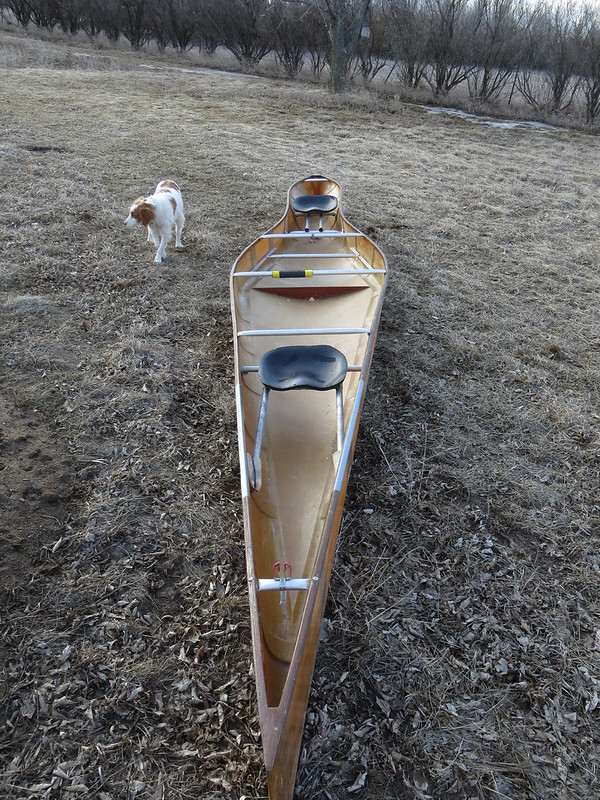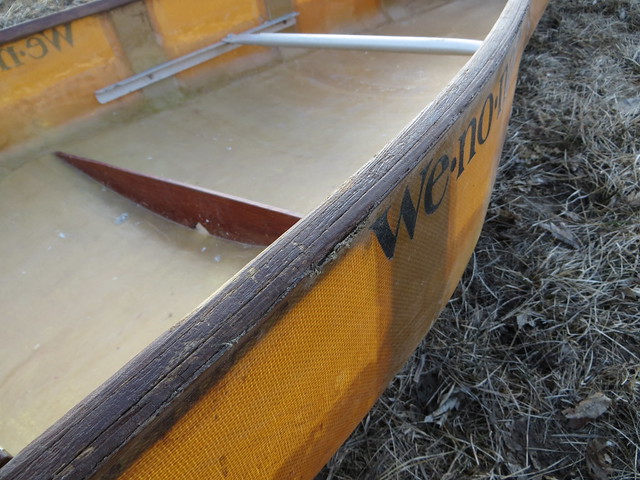If the seal coat is still tacky, it's gonna create some problems for you when you put the cloth on. I have gone both ways (fiberglassing I mean). If I have an abundance of resin, I will usually put a seal coat on, as it will give a more consistent finish. However, I really don't think it makes any difference to the strength of the hull. I like to pre coat the inside, because it seems to prevent outgassing and decreases bubble formation in the glass.
-
Happy National Blueberry Pie Day! 🫐🥧
You are using an out of date browser. It may not display this or other websites correctly.
You should upgrade or use an alternative browser.
You should upgrade or use an alternative browser.
Barracuda Build
- Thread starter Alan Gage
- Start date
In my mind, and this might not match up with reality, laying cloth on tacky resin would only be a problem until the cloth was wet out at which point it move around freely. But perhaps that's not the case.
Alan
Alan
How will you move the cloth to where you need it once it sticks to the tacky resin? Much easier to position on green sanded resin.
How will you move the cloth to where you need it once it sticks to the tacky resin? Much easier to position on green sanded resin.
You're probably right. I was thinking I could have the cloth precut and that I would be able to lay it over the slightly tacky epoxy and, while not as easy as a smooth hull, still get the wrinkles out. But the more I think about it the more I remember how quickly everything gets sticky, including hands, and it would probably turn into an exercise in futility. So scratch that idea.
Got the hull nearly ready for fiberglass today. There will be some final tweaking of the stems and I need to hand sand near the crease at the gunnels where the sander couldn't reach.
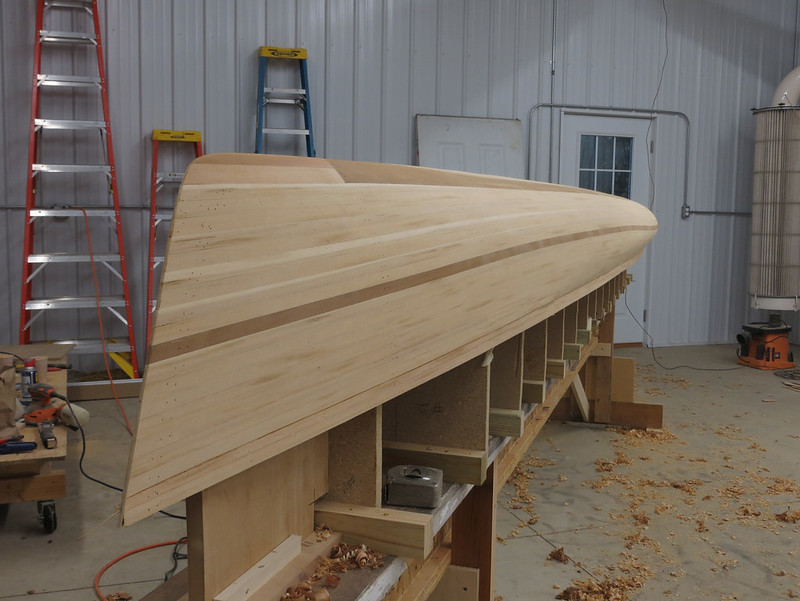
20140720_002_1 by Alan Gage, on Flickr

20140720_004_1 by Alan Gage, on Flickr
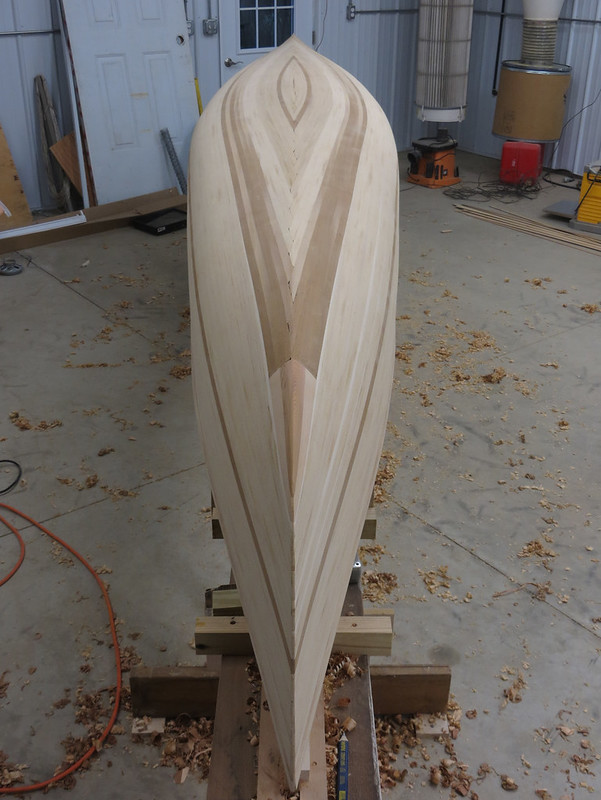
20140720_005_1 by Alan Gage, on Flickr
I didn't get all the strips to fit together perfect towards the stems so after sanding there are some gaps:
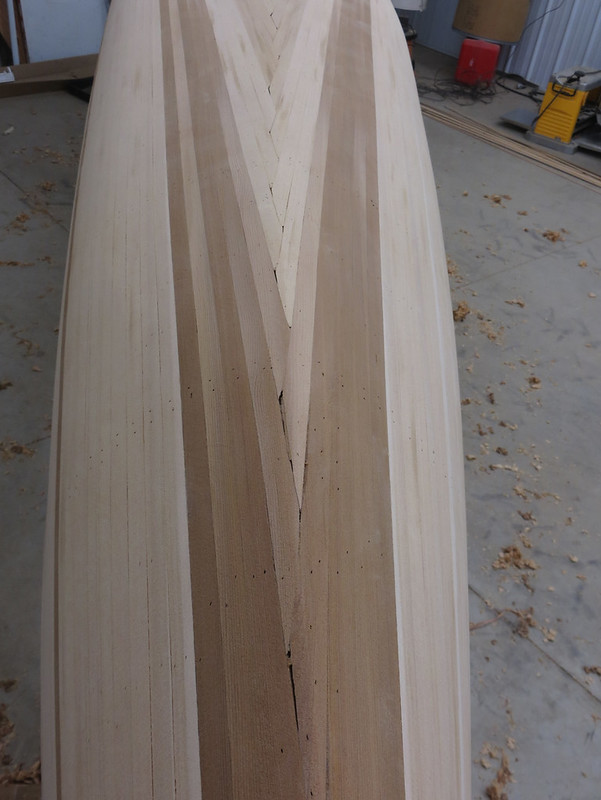
20140720_007_1 by Alan Gage, on Flickr
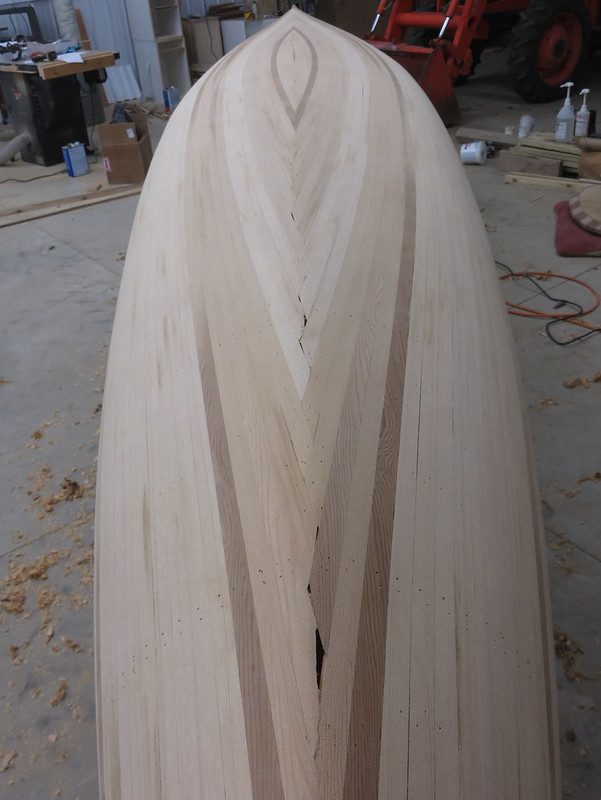
20140720_008_1 by Alan Gage, on Flickr
I put tape on the underside of the hull everywhere I could see light coming through. This will keep the epoxy from dripping through to the inside. Then I thickened some epoxy with cedar dust I saved from sanding the hull and filled in the gaps. I'll sand it smooth tomorrow. A bit darker than I would have liked. Perhaps I should have thickened it with cabosil and just added a little cedar dust for coloring.
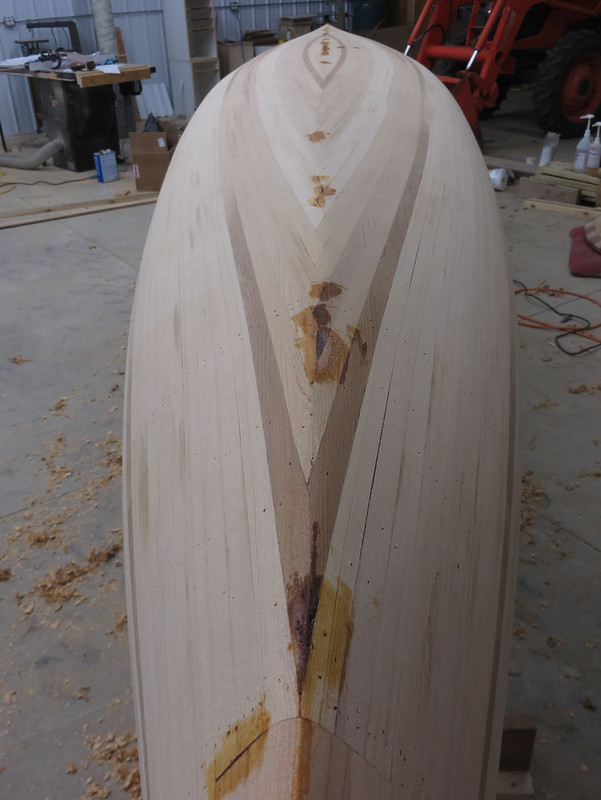
20140720_009_1 by Alan Gage, on Flickr
Alan

20140720_002_1 by Alan Gage, on Flickr

20140720_004_1 by Alan Gage, on Flickr

20140720_005_1 by Alan Gage, on Flickr
I didn't get all the strips to fit together perfect towards the stems so after sanding there are some gaps:

20140720_007_1 by Alan Gage, on Flickr

20140720_008_1 by Alan Gage, on Flickr
I put tape on the underside of the hull everywhere I could see light coming through. This will keep the epoxy from dripping through to the inside. Then I thickened some epoxy with cedar dust I saved from sanding the hull and filled in the gaps. I'll sand it smooth tomorrow. A bit darker than I would have liked. Perhaps I should have thickened it with cabosil and just added a little cedar dust for coloring.

20140720_009_1 by Alan Gage, on Flickr
Alan
G
Guest
Guest
What a gorgeous boat! I think its initial stability will be pretty good. One of the shots shows the tumblehome, and the hull shape looks a lot like the Wenonah Prism and Solo Plus, both of which have pretty good initial. But like them, you probably won't be able to lean it very far before the tumblehome gets submerged.
I use a wood filler that comes in toothpaste like tubes. It comes in several different colours, so you can come close matching most woods. Thickened epoxy can sometimes be difficult to sand, and also sometimes can cause colour variations.
Sanded down the thickened epoxy used to fill and gaps and gave the stems their final shape. The hull has had it's final sanding and it's ready for fiberglass.
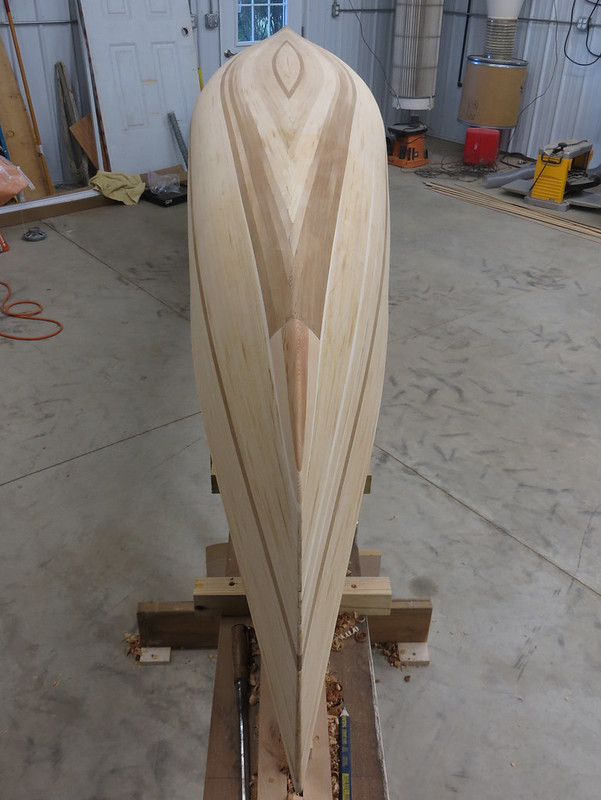
20140722_001_1 by Alan Gage, on Flickr
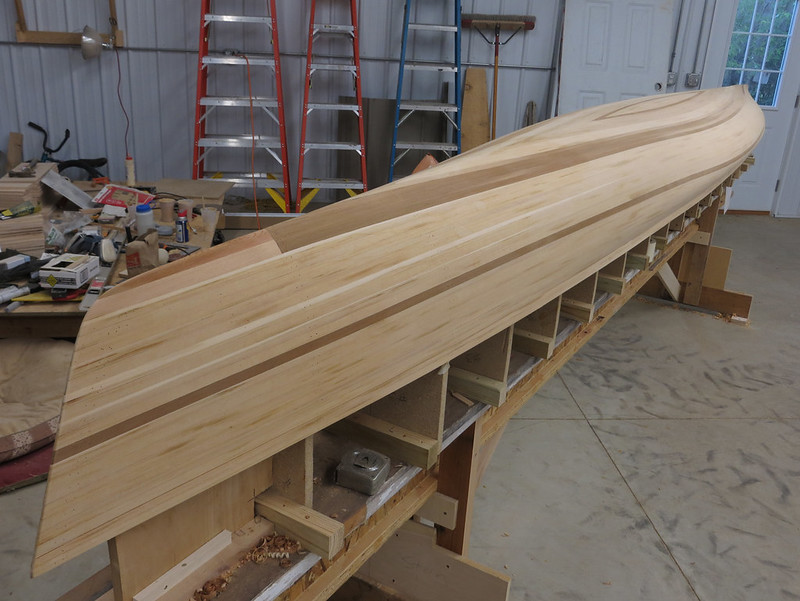
20140722_002_1 by Alan Gage, on Flickr
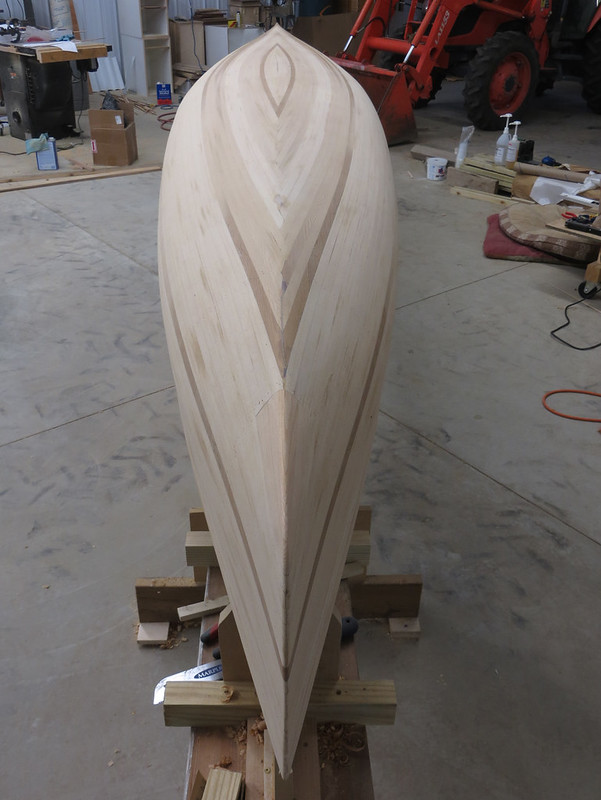
20140722_003_1 by Alan Gage, on Flickr
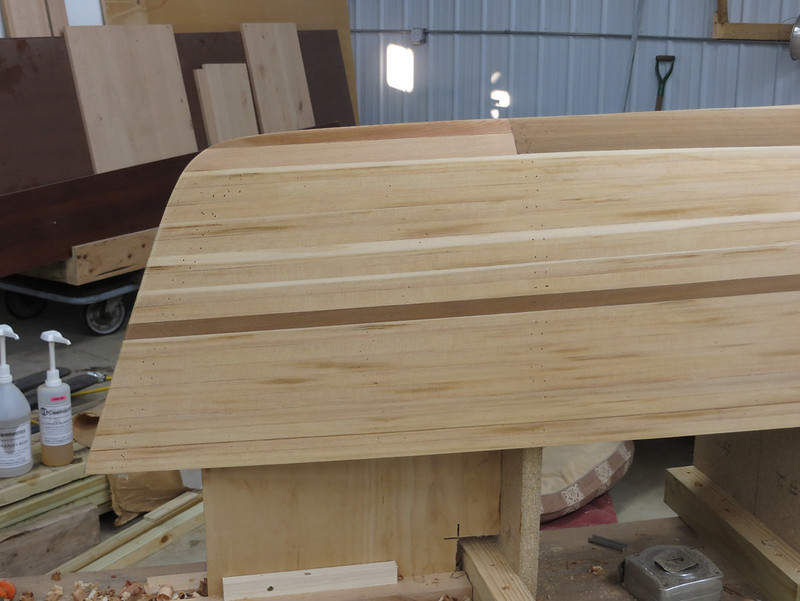
20140722_005_1 by Alan Gage, on Flickr
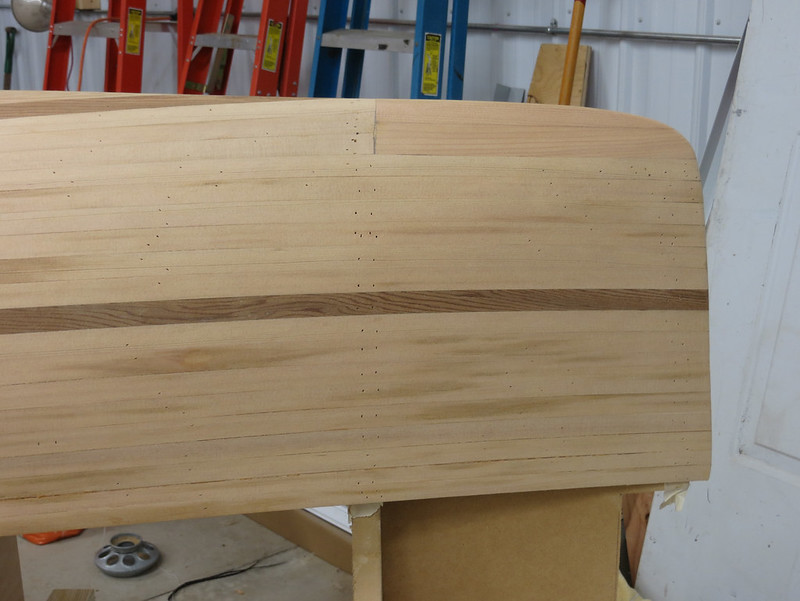
20140722_006_1 by Alan Gage, on Flickr
Cooler weather is coming tomorrow so instead of doing the whole thing today in the hot(ish) shop I just put a few pieces on the stems for extra protection. A friend was over tonight so I was talking as much as I was working and I was moving a little slow but I was surprised how fast the epoxy in the cup started to kick. Hopefully it will be 10 degrees cooler in the shop tomorrow and I'll make a point to move a little faster.
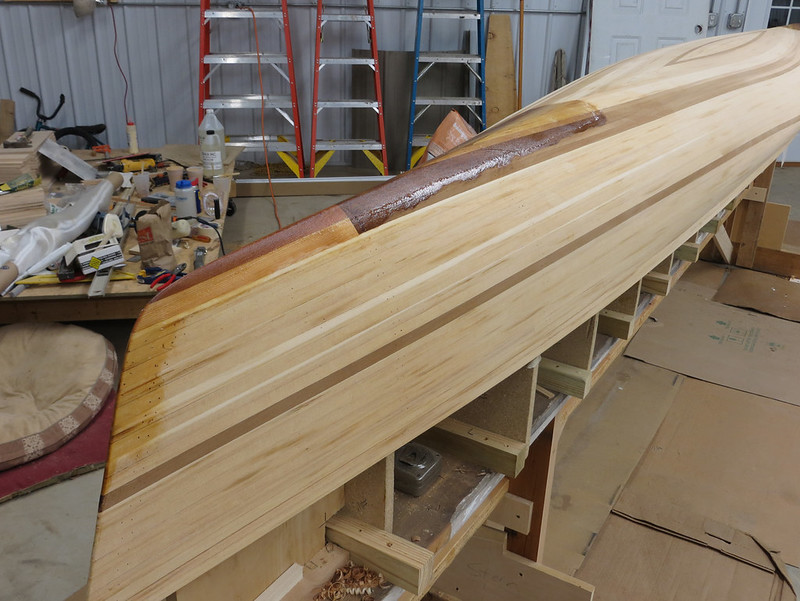
20140722_007_1 by Alan Gage, on Flickr
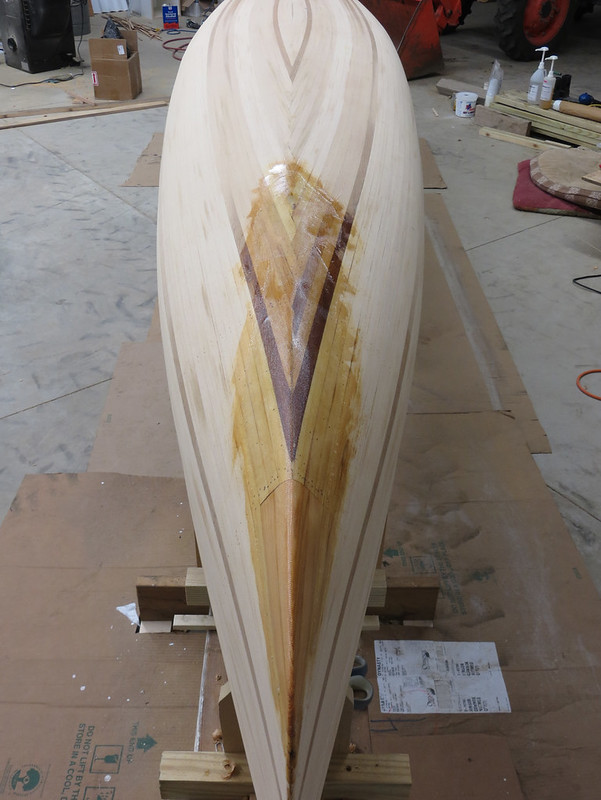
20140722_010_1 by Alan Gage, on Flickr
Tomorrow I hope to post pictures of a fully fiberglassed hull. Can't wait!
Alan

20140722_001_1 by Alan Gage, on Flickr

20140722_002_1 by Alan Gage, on Flickr

20140722_003_1 by Alan Gage, on Flickr

20140722_005_1 by Alan Gage, on Flickr

20140722_006_1 by Alan Gage, on Flickr
Cooler weather is coming tomorrow so instead of doing the whole thing today in the hot(ish) shop I just put a few pieces on the stems for extra protection. A friend was over tonight so I was talking as much as I was working and I was moving a little slow but I was surprised how fast the epoxy in the cup started to kick. Hopefully it will be 10 degrees cooler in the shop tomorrow and I'll make a point to move a little faster.

20140722_007_1 by Alan Gage, on Flickr

20140722_010_1 by Alan Gage, on Flickr
Tomorrow I hope to post pictures of a fully fiberglassed hull. Can't wait!
Alan
Looking ahead a bit I'm still trying to figure out what to do for gunwales. Would like to keep it lightweight and simple. This boat will not be carrying big loads, be portaged farther than from the car to the lake, and won't be running any rapids. What can I get away with?
I once owned a Cal Stenso built V1 in woodstrip. It had no gunwales, the top strip just felt a bit thicker than the rest. It had some extra bracing in other areas of the boat to perhaps make up for it. Actually looking closer at the pictures now it looks like there is a very thin piece at the very top. This must be what gave it that feel I remember of the top strip being slightly thicker. Either way it couldn't have been more than 3/8" wide total and maybe less than that.
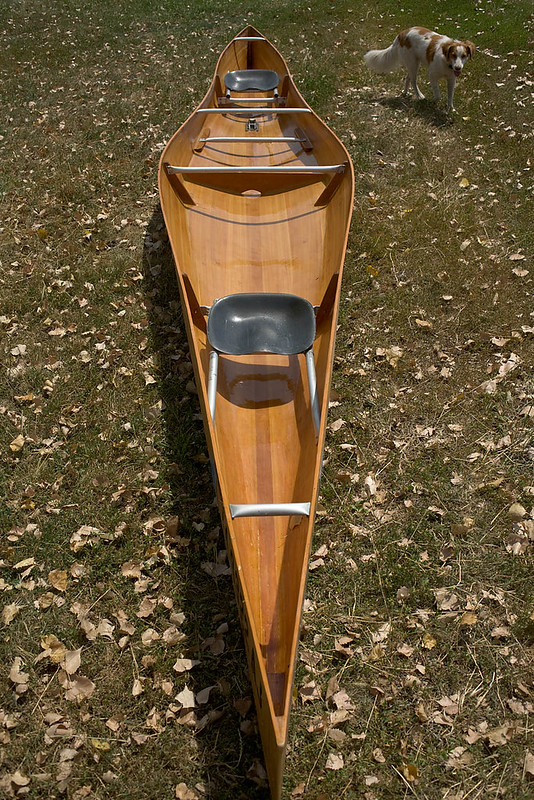
_MG_6490 copy_web by Alan Gage, on Flickr
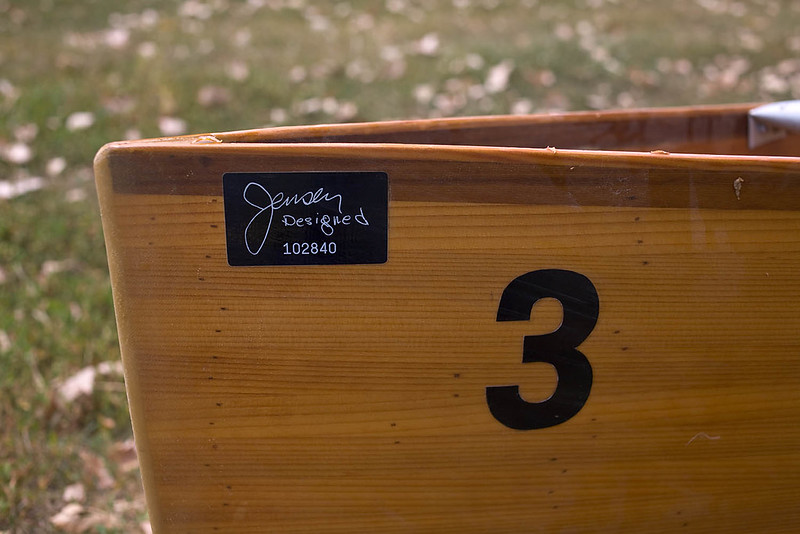
_MG_6500 copy_web by Alan Gage, on Flickr
I also once owned a carbon Crozier built J-203. The boat was of course all carbon with integrated gunwales but they didn't have a traditional gunwale profile. Just a but thicker than the rest of the boat.
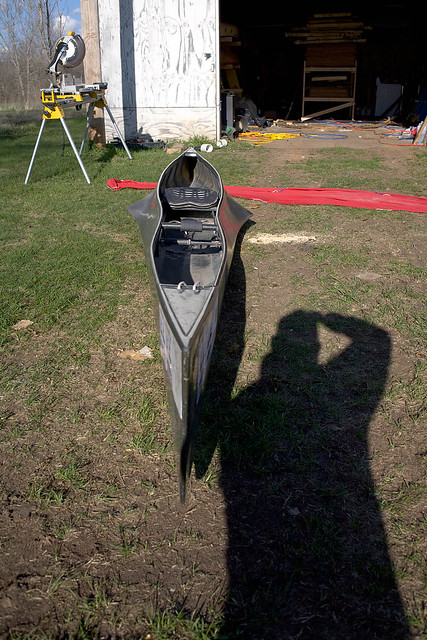
20110505_004 copy_web by Alan Gage, on Flickr
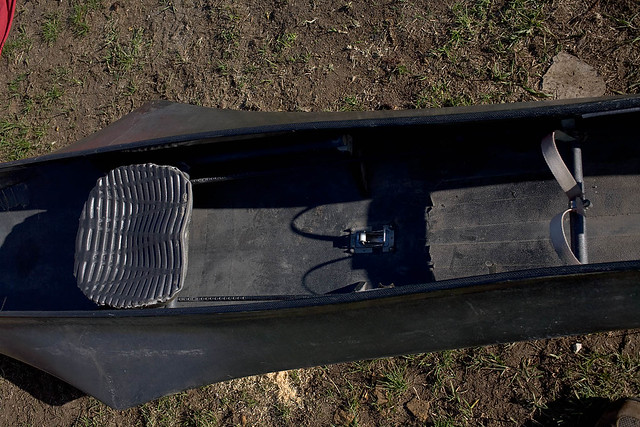
20110505_013 copy_web by Alan Gage, on Flickr
Then there were these two old J-boats from back in the day. A J-180 and Wabash Valley X-Cell:
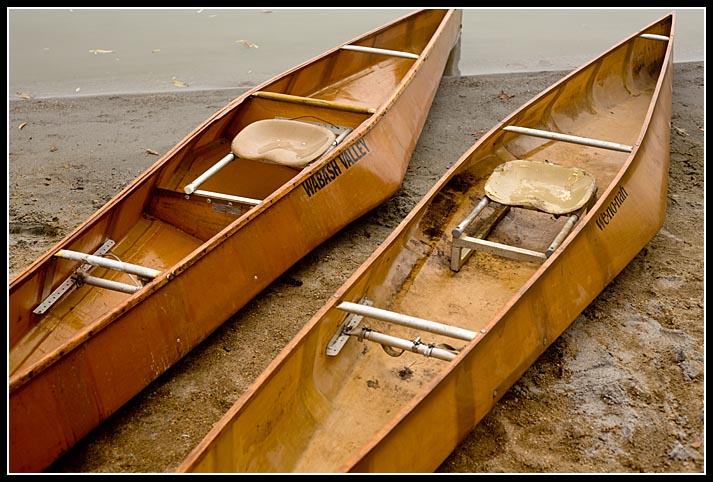
20090907_004 copy_web by Alan Gage, on Flickr
Tough to see in the pics but from what I remember the Wenonah had only a thin wood inwale with no outwale. The Wabash valley looks to have a small inwale and outwale. Here's a better look at it:
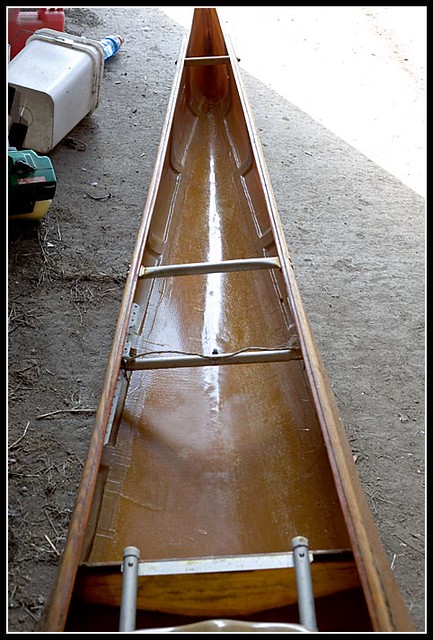
20090907_015 copy_web by Alan Gage, on Flickr
I kind of like the idea of just doing an inwale like on the J-180 above. I'm out of cedar but have some clear Alder that I could scarf together.
Thoughts or suggestions?
Alan
I once owned a Cal Stenso built V1 in woodstrip. It had no gunwales, the top strip just felt a bit thicker than the rest. It had some extra bracing in other areas of the boat to perhaps make up for it. Actually looking closer at the pictures now it looks like there is a very thin piece at the very top. This must be what gave it that feel I remember of the top strip being slightly thicker. Either way it couldn't have been more than 3/8" wide total and maybe less than that.

_MG_6490 copy_web by Alan Gage, on Flickr

_MG_6500 copy_web by Alan Gage, on Flickr
I also once owned a carbon Crozier built J-203. The boat was of course all carbon with integrated gunwales but they didn't have a traditional gunwale profile. Just a but thicker than the rest of the boat.

20110505_004 copy_web by Alan Gage, on Flickr

20110505_013 copy_web by Alan Gage, on Flickr
Then there were these two old J-boats from back in the day. A J-180 and Wabash Valley X-Cell:

20090907_004 copy_web by Alan Gage, on Flickr
Tough to see in the pics but from what I remember the Wenonah had only a thin wood inwale with no outwale. The Wabash valley looks to have a small inwale and outwale. Here's a better look at it:

20090907_015 copy_web by Alan Gage, on Flickr
I kind of like the idea of just doing an inwale like on the J-180 above. I'm out of cedar but have some clear Alder that I could scarf together.
Thoughts or suggestions?
Alan
Alan,
Phenomenal progress on your hull!!
I just (almost) finished that Kite...For my gunnels, I used a substrate of foam wrapped with a layer of carbon fiber, and a short section of reinforcing glass tape where the gunnels rest on a roof rack. Very lightweight, plenty strong, and good looking, but labor intensive. And a slow process, I waited a lot between efforts for the epoxy to cure...
Phenomenal progress on your hull!!
I just (almost) finished that Kite...For my gunnels, I used a substrate of foam wrapped with a layer of carbon fiber, and a short section of reinforcing glass tape where the gunnels rest on a roof rack. Very lightweight, plenty strong, and good looking, but labor intensive. And a slow process, I waited a lot between efforts for the epoxy to cure...
Alan,
For my gunnels, I used a substrate of foam wrapped with a layer of carbon fiber, and a short section of reinforcing glass tape where the gunnels rest on a roof rack. Very lightweight, plenty strong, and good looking, but labor intensive. And a slow process, I waited a lot between efforts for the epoxy to cure...
I'd love to try something like that but at this point it's not in the budget or the timeframe. If it was January I'd probably go for it but considering I want to paddle it this summer I'm looking for quick and cheap. Love the way it looks on your Kite though.
Alan
I'm no lightweight builder, but I'm positive inwales only will give you enough hull integrity. If you are not hanging your seat, you could probably go pretty thin too.
I'm no lightweight builder, but I'm positive inwales only will give you enough hull integrity. If you are not hanging your seat, you could probably go pretty thin too.
Well that's good enough for me, I'll see what I can come up with. Thanks.
Can't believe how slow the day is going! All I want to do is go home and fiberglass!!!
Alan
Had to get my boat fix on so when I was home for lunch I sanded down the fiberglass patches I laid last night so that the edges had a smooth transition to the hull. These cover the weakest areas of the hull (where I planed too far) and it's surprising how much just one layer of 4 oz cloth firmed things up. I'll probably put down a few more small wear/reinforcement patches with the rest of the cloth tonight. Is it 5:00 yet?
Alan
Alan
What about taking some 1/2" x 1/2" hardwood stock and ripping out the corner to sit on top of the cedar edge for inwales only? You could put a small round over on the outside corner just to ease the edge, and to act as a rub surface. Depending on the material chosen, it will probably wear a lot slower than cedar will.
I can post a sketch if I didn't communicate the idea well enough. Just a suggestion though. You guys have done this way more times than I have.
Momentum
I can post a sketch if I didn't communicate the idea well enough. Just a suggestion though. You guys have done this way more times than I have.
Momentum
What about taking some 1/2" x 1/2" hardwood stock and ripping out the corner to sit on top of the cedar edge for inwales only? You could put a small round over on the outside corner just to ease the edge, and to act as a rub surface. Depending on the material chosen, it will probably wear a lot slower than cedar will.
If I'm picturing what you mean correctly I think you're talking about cutting a rabbet so there would be a thin lip that overlays the top strip. I can see where that would work. Right now I'm leaning towards a relatively thin inwale of alder, tapering so that it's wider at the top with with an eased edge, and fiberglass it in place the same time I do the rest of the inside. A rabbet would probably be easy enough to add.
Just a suggestion though. You guys have done this way more times than I have.
You give me too much credit. This is only my second build and I've never worked with wood gunwales. I used aluminum on my Kite to save time and weight.
Thanks for the input!
PS, only an hour to go......
Alan
Alan- You are correct in what I described. I understand where you are coming from, as far as keeping it thin and light.
You really have done this more than I...just finishing a Hiawatha 15 build, and plan to keep my gunwales as light as I can while still keeping the asthetic appeal of inwale scuppers and tapered outwales.
So, you guys have way more knowledge at this. Great build
Momentum
You really have done this more than I...just finishing a Hiawatha 15 build, and plan to keep my gunwales as light as I can while still keeping the asthetic appeal of inwale scuppers and tapered outwales.
So, you guys have way more knowledge at this. Great build
Momentum
Alan,
Do you use Dynel on your stems?
It is still the most abrasion resistant fiber you can use.
Some folks avoid it because it soaks up resin like an old sweatshirt, and has an ugly yellow tint to it. Being very abrasion resistant, it's also tough to sand, but it does hold up extremely well if you beach your boat often.
Do you use Dynel on your stems?
It is still the most abrasion resistant fiber you can use.
Some folks avoid it because it soaks up resin like an old sweatshirt, and has an ugly yellow tint to it. Being very abrasion resistant, it's also tough to sand, but it does hold up extremely well if you beach your boat often.
Alan,
Do you use Dynel on your stems?
It is still the most abrasion resistant fiber you can use.
Some folks avoid it because it soaks up resin like an old sweatshirt, and has an ugly yellow tint to it. Being very abrasion resistant, it's also tough to sand, but it does hold up extremely well if you beach your boat often.
I'd never heard of it until I read your Kite thread. Sounds like interesting stuff and now that I know the name I seem to see it everywhere. I didn't use any here. It's a flatwater world out here in the midwest so all it takes is a little caution and river reading ability to give a canoe a pretty easy life. I'll certainly keep it in mind for future builds that might see some more "extreme" conditions though.
Alan
Similar threads
- Replies
- 14
- Views
- 1K
- Replies
- 138
- Views
- 9K
- Replies
- 73
- Views
- 6K

